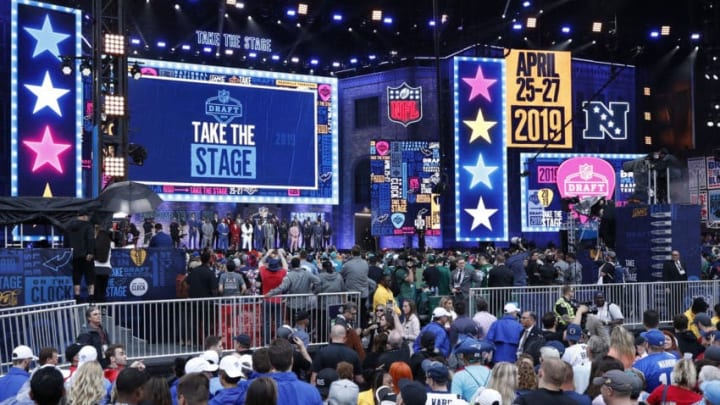The Dallas Cowboys’ front office has received positive attention for their drafts over the last eight years. Should Jason Garrett receive some credit?
We all know that Jerry Jones is the man who calls the shots for the Dallas Cowboys. He has the title of Owner, President and General Manager. But just like on the field, it takes a team effort to win in the front office.
His son Stephen Jones, the Cowboys Chief Operating Officer, Executive Vice President and Director of Player Personnel has taken a more active role with player acquisition and contract negotiations in the past decade.
Will McClay joined the Cowboys organization in 2002 as the defensive coordinator of the Jerry Jones owned Dallas Desperadoes of the Arena Football League. He progressed through the Cowboys front office rising to his current role of Vice President of Player Personnel.
McClay and Stephen Jones were largely credited with preventing Jerry Jones from drafting quarterback Johnny Manziel. Instead, the Cowboys drafted All Pro guard Zack Martin and have benefited each time a running back carries the ball or the quarterback throws a pass.
But there is a forgotten man in this equation. Jason Garrett became the interim head coach of the Dallas Cowboys on November 8, 2010 after Wade Phillips was fired. The interim title was removed on January 6, 2011.
The Cowboys draft track record during Phillips tenure was not the greatest and likely resulted in his firing as the roster quality slowly eroded. Phillips was the head coach from 2007 through 2010 and was in the War Room for four drafts with the Cowboys.
The Cowboys most notable picks from the 2007 draft were edge rusher Anthony Spencer and offensive lineman Doug Free. The team had two first round picks in 2008 but the cornerback drafted in the fifth round, Orlando Scandrick, made the biggest impact.
If 2009 was not the worst draft in Cowboys history, it ranks close as only two of the twelve picks made even marginal contributions, tight end John Phillips and defensive end Victor Butler. The 2010 draft may have been the start of the recent draft success as wide receiver Dez Bryant and linebacker Sean Lee were the first two picks.
In a perfect world, first round draft picks would be Hall of Fame players, second round draft picks would be Pro Bowl players, third round picks would be core pieces and fourth round picks would be solid contributors. But drafting is an inexact science with many variables after the draft such as coaching, love for the game and avoiding distractions helping to determine the prospects success.
NFL teams speak loudly when they offer a contract to a player. Each draft pick receives a salary controlled rookie contract. But a second contract is not guaranteed. The player’s performance over their first four years in the league determines if they earn a second contract.
Using a second NFL contract as the measuring stick, I compared the drafts of every team from 2007 to 2010. Nearly 71 percent of the prospects drafted in the first four rounds during this period received a second contract, not necessarily with the team that drafted them.
The Atlanta Falcons and New York Jets led the NFL with 90 percent of their drafted players receiving a second contract. The New England Patriots were last with only 52 percent. The Dallas Cowboys, in the Wade Phillips years, were just under average with 69 percent.
The average for all prospects drafted in the first four rounds of the 2011 to 2014 drafts receiving a second contract dropped slightly to just below 68 percent. However, with Jason Garrett as the coach in the Cowboys War Room during this period, the Cowboys draft performance improved significantly.
In fact, 15 of the 16 draft picks received a second contract. The only player not to receive a second contract was 2012 fourth round pick Matt Johnson, a safety from Eastern Washington. If you want to play coulda, woulda, shoulda, defensive lineman Malik Jackson, now of the Philadelphia Eagles, was picked two spots after Johnson.
While a second contract truly identifies a professional football player, it doesn’t attest the quality of that player. I am not a believer that Pro Bowl selections are a true indication of a player’s performance but the five Cowboys drafted from this period to make the Pro Bowl, offensive lineman Tyron Smith, Travis Frederick and Zack Martin, defensive lineman DeMarcus Lawrence and running back DeMarco Murray truly are superior players.
For comparison purposes, the New York Giants had one Pro Bowl draft pick and the Washington Redskins and Philadelphia Eagles each had four Pro Bowl selections over this four-year period. The Green Bay Packers and Minnesota Vikings led the NFL with seven Pro Bowl picks followed by the Kansas City Chiefs with six.
Say what you want about Jason Garrett the game day coach. You might not like his game management skills or the amount of clapping he does on the sideline. You likely grow tired of his “right kind of guy” expression.
But it seems like he has been able to communicate to the Front Office the type of players he wants to coach. To their credit, the Front Office has delivered these players.
